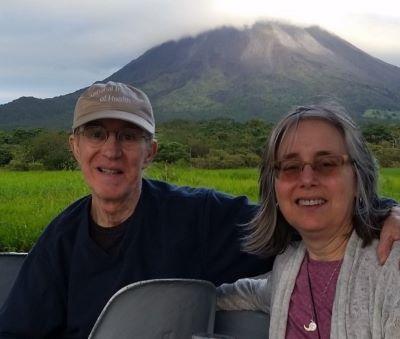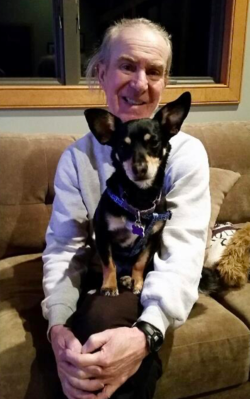An active cyclist and outdoor enthusiast, Bob made many lifestyle changes to accommodate his needs as he underwent treatment for his glioblastoma.
By Bob, Glioblastoma Survivor
July 1, 2020
In Memoriam
We pay tribute to the life of Bob. We are grateful he chose to share his diagnosis, treatment, and cancer journey with us to help improve treatments for others. Our condolences go out to his wife Barbara, family, and friends.
Before being diagnosed with glioblastoma at 63 years old, I was a competitive bicyclist, outdoor enthusiast, and an avid baseball fan. When I was diagnosed on April 1, 2015, everything changed.
My first symptoms started in the fall of 2014 with dizziness, disorientation, and vision changes, which included flashing in my eyes. But because I was still able to ride my bike with my wife Barbara by my side, we really didn’t think anything was drastically wrong.
But, over time, riding my bike became more and more scary. I found myself losing balance and it felt like I could get knocked over easily.
When things continued to get worse, I saw a variety of specialists who did not find anything wrong. Finally, my cardiologist thought my symptoms were caused by a clogged artery in my neck and the flashing in my eyes was misdiagnosed as transient ischemic attacks (TIA).
The doctors performed an endarterectomy of the right artery to remove any large plaques, and were getting ready to perform another on my left artery when my symptoms didn’t improve. It was then that another physician suggested a magnetic resonance imaging (MRI) scan. Finally, they saw it: a lesion that was likely an aggressive brain tumor.
I was soon referred to a city hospital and told the tumor was too risky to operate on, but they performed a biopsy to determine what kind of brain tumor it was. After waiting 10 days for the results, which felt like an eternity, we had to show up at the hospital to demand answers.
I will never forget the way the doctors looked at me. They said that I was diagnosed with glioblastoma, an aggressive brain tumor with no cure. It felt like a death sentence. We were horrified and heartbroken, and we did not feel comfort or hope from our providers.
Seeking a Second Opinion
But hope came in the best way we could have imagined. Just a few days later, we were able to get an appointment at the NCI Center for Cancer Research's Neuro-Oncology Branch (NOB) at NIH. We fell in love right away with the culture of kindness and compassion that each and every person showed us.
During our first visit on April 16, 2015, we saw NOB Chief Mark Gilbert, M.D., and he completely changed our outlook on my diagnosis. The NOB care team spent as long as we wanted answering our questions and outlining treatment options for us.
The same day, Kevin Camphausen, M.D., chief of the Radiation Oncology Branch, met with us to discuss treatment options. It was a huge relief to be able to see the road ahead of us with a sentiment of hope. It was amazing to see how the doctors, nurses, and clinical staff treated each patient who walked through their doors, and we felt lucky to have this resource close to home.
After that, I received radiation at NIH and chemotherapy through a community physician. I even participated in a monitoring protocol with the Radiation Oncology Branch to see how long radiation stays inside my body, so that researchers can learn more about its effects and help others in the future.
Treating My Recurrence
I was one of the lucky few with a glioblastoma to gain what is considered to be long-term stability. Although I was stable for a long time, the doctors did detect a recurrence in the fall of 2019. I underwent a surgery by Neurosurgeon Edjah Nduom, M.D., of the National Institute of Neurological Disorders and Stroke at NIH to remove the tumor.
This time, I enrolled in an NIH clinical trial combining a traditional chemotherapy drug and the drug TG02, now called zotiraciclib. During my treatment, I endured many common drug side effects—severe nausea, fatigue, and dizziness—but the NOB team always carefully monitored me throughout the trial for my safety. While I eventually stopped the chemotherapy because of low white blood cell counts, I’m still taking zotiraciclib. The study investigator, Jing Wu, M.D., Ph.D., and NOB Research Nurse Matt Lindsley stay in close contact about my progress.
In our five years with the NIH, the care has never failed us, thanks to their "person-first" approach. I’ve had the immense pleasure of knowing and being cared for by multiple members of the NOB team, and my treatment is currently overseen by Neuro-Oncologist Brett Theeler, M.D., and Nurse Practitioner Ramya Antony. We still visit NIH every two weeks for blood work, once a month for clinic appointments, and every two months for scans.
A New Perspective on Life
Life has definitely changed a great deal since my diagnosis. We have learned so much about the medical system and how to find care that addresses our needs. I’ve also had to accept my current life. I am not able to do everything I used to and need help from others.
I wouldn’t have the kind of life I have now if it weren't for the cancer. It forced to me to focus on my well-being and be better about nutrition. Mindfulness and other complementary techniques—such as massage and acupuncture—have also really helped me release stress and make my body feel better. I am now more compassionate, caring, and far less judgmental of others.
Because I can’t ride my bike anymore, Barbara and I switched to walking with our newly adopted dog, Axle. Now, I’m usually too tired or have trouble with balance, so I’ve turned to other new hobbies, including poetry. I would never have thought that poetry would give me so much joy, but I’m even called the resident poet in my regular support group now!
I have also learned to open up to people more, which does help a great deal. My wife and I have shared our experience through a CaringBridge blog. This way, we don’t have to share updates with each person individually, but still stay in touch with friends and family who have been so supportive and helpful.
I’ve realized that we are never really in control of our lives. This experience has taught me to not only live my life to the fullest, but also surrender to everything that comes my way. Despite the challenges I deal with every day, I feel like I have finally become a whole person and a much better human being through this journey.

